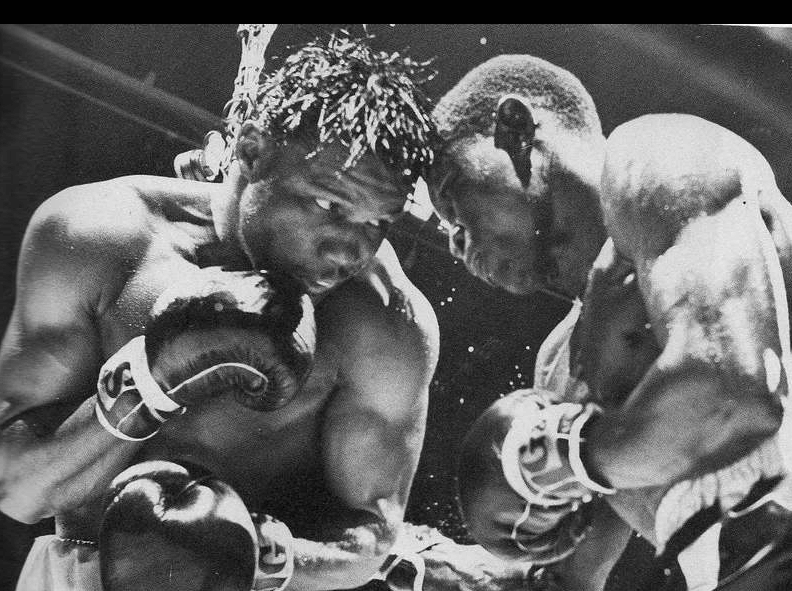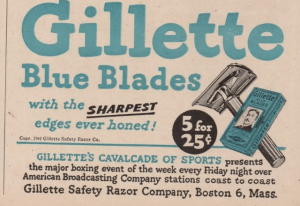Featured Articles
60 Years Ago This Month, the Curtain Fell on the Golden Era of TV Boxing

The Sept. 11, 1964 fight between Dick Tiger and Don Fullmer marked the end of an era. The bout aired on ABC which had taken the reins from NBC four years earlier. This would be the final episode of the series informally known as the “Friday Night Fights” or the “Fight of the Week,” closing the door on a 20-year run. In the future, boxing on free home TV (non-cable) would be sporadic, airing mostly on Saturday and Sunday afternoons. The days when boxing was a weekly staple on at least one major TV network were gone forever.
During the NBC years, the show ran on Friday in the 10:00-11-00 pm slot for viewers in the Eastern Time Zone and the “studio” was almost always Madison Square Garden. The sponsor from the very beginning was the Gillette razor company (during the ABC run, El Producto Cigars came on as a co-sponsor).
Gillette sponsored many sporting events – the Kentucky Derby, the World Series, the U.S. Open golf tournament and the Blue-Gray college football all-star game, to name just a few – all of which were bundled under the handle of the Gillette Cavalcade of Sports. Every sports fan in America could identify the catchphrase that the company used to promote their disposable “Blue Blades” – “Look Sharp, Feel Sharp, Be Sharp!” — and the melody of the Gillette jingle would become the most-played tune by marching bands at high school and college football halftime shows (the precursor, one might say, of the Kingsmen’s “Louie, Louie”).

The Sept. 11 curtain-closer wasn’t staged at Madison Square Garden but in Cleveland with the local area blacked out.
Dick Tiger, born and raised in Nigeria, was making his second start since losing his world middleweight title on a 15-round points decision to Joey Giardello. Don Fullmer would be attempting to restore the family honor. Dick Tiger was 2-0-1 vs. Gene Fullmer, Don’s more celebrated brother. Their third encounter, which proved to be Gene Fullmer’s final fight, was historic. It was staged in Ibadan, Nigeria, the first world title fight ever potted on the continent of Africa.
In New York, the epitaph of free TV boxing was written three weeks earlier when veteran Henry Hank fought up-and-comer Johnny Persol to a draw in a 10-round light heavyweight contest at the Garden. This was the final Gillette fight from the place where it all started.
Some historians trace the advent of TV boxing in the United States to Sept. 29, 1944, when a 20-year-old boxer from Connecticut, Willie Pep, followed his manager’s game plan to perfection, sticking and moving for 15 rounds to become the youngest featherweight champion in history, winning the New York version of the title from West Coast veteran Albert “Chalky” Wright.
There weren’t many TVs in use in those days. As had been true when the telephone was brand new, most were found in hospitals, commercial establishments, and in the homes of the very wealthy. But within a few years, with mass production and tumbling prices, the gizmo became a living room staple and the TV repairman, who made house calls like the family doctor, had a shop on every Main Street.
Boxing was ideally suited to the infant medium of television because the action was confined to a small area that required no refurbishment other than brighter illumination, keeping production costs low. The one-minute interval between rounds served as a natural commercial break. The main drawback was that a fight could end early, meaning fewer commercials for the sponsor who paid a flat rate.
At its zenith, boxing in some locales aired five nights a week. And it came to be generally seen that this oversaturation killed the golden goose. One by one, the small fight clubs dried up as fight fans stayed home to watch the fights on TV. In the big arenas, attendance fell off drastically. Note the difference between Pep vs. Wright, the 1944 originator, and Hank vs. Persol, also at Madison Square Garden:
Willie Pep vs. Chalky Wright Sept. 29, 1944 attendance 19,521
Henry Hank vs. Johnny Persol Aug. 21, 1964 attendance 5,219
(True, Pep vs. Wright was a far more alluring fight, but this fact alone doesn’t explain the wide gap. Published attendance counts aren’t always trustworthy. In the eyes of the UPI reporter who covered the Hank-Persol match, the crowd looked smaller. He estimated the attendance at 3,000.)
Hank vs. Persol was an entertaining bout between evenly-matched combatants. The Tiger-Fullmer bout, which played out before a sea of empty seats, was a snoozer. Don Fullmer, a late sub for Rocky Rivero who got homesick and returned to Argentina, was there just for the paycheck. A Pittsburgh reporter wrote that the match was as dull as a race between two turtles. Scoring off the “5-point-must” system, the judges awarded the match to Dick Tiger by margins of 6, 6, and 7 points.
And that was that. Some of the most sensational fights in the annals of boxing aired free on a major TV network, but the last big bang of the golden era was hardly a bang, merely a whimper.
—
A recognized authority on the history of prizefighting and the history of American sports gambling, TSS editor-in-chief Arne K. Lang is the author of five books including “Prizefighting: An American History,” released by McFarland in 2008 and re-released in a paperback edition in 2020.
—
The photo accompanying this article is from the 1962 fight at Madison Square Garden between Dick Tiger (on the right) and Henry Hank. To comment on this story in the Fight Forum CLICK HERE
-

 Featured Articles2 weeks ago
Featured Articles2 weeks agoThe Hauser Report: Zayas-Garcia, Pacquiao, Usyk, and the NYSAC
-

 Featured Articles2 weeks ago
Featured Articles2 weeks agoOscar Duarte and Regis Prograis Prevail on an Action-Packed Fight Card in Chicago
-

 Featured Articles7 days ago
Featured Articles7 days agoThe Hauser Report: Cinematic and Literary Notes
-

 Book Review2 days ago
Book Review2 days agoMark Kriegel’s New Book About Mike Tyson is a Must-Read
-

 Featured Articles4 weeks ago
Featured Articles4 weeks agoManny Pacquiao and Mario Barrios Fight to a Draw; Fundora stops Tim Tszyu
-

 Featured Articles3 weeks ago
Featured Articles3 weeks agoArne’s Almanac: Pacquiao-Barrios Redux
-

 Featured Articles2 weeks ago
Featured Articles2 weeks agoRemembering Dwight Muhammad Qawi (1953-2025) and his Triumphant Return to Prison
-

 Featured Articles4 weeks ago
Featured Articles4 weeks agoOleksandr Usyk Continues to Amaze; KOs Daniel Dubois in 5 One-Sided Rounds


















